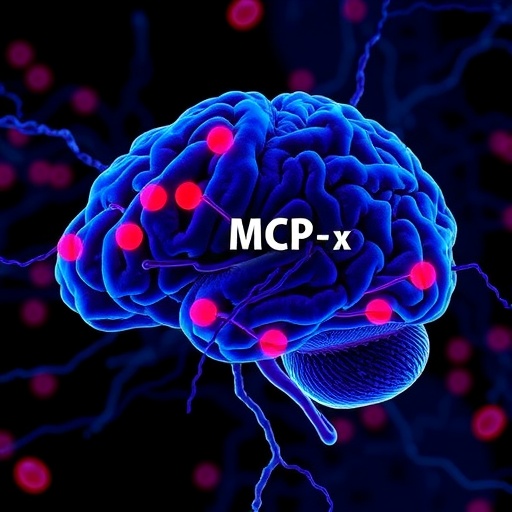In an era where the molecular underpinnings of Alzheimer’s disease continue to elude definitive understanding, a groundbreaking study emerges from the laboratories of Huang, Wang, Stein, and colleagues, shedding compelling light on the interplay between inflammatory biomarkers and genetic variability in modulating disease trajectories. Published recently in Translational Psychiatry, this research offers a nuanced exploration of how circulating levels of Monocyte Chemoattractant Protein-1 (MCP-1) intersect with genetic polymorphisms at the NAV3 and UNC5C loci to influence Alzheimer’s pathogenesis.
Alzheimer’s disease (AD), a neurodegenerative disorder marked by progressive cognitive decline and memory loss, remains one of the most formidable challenges in contemporary neuroscience and medicine. The multifaceted etiology of AD involves complex interactions between genetic susceptibilities, inflammatory processes, and environmental factors. This new study particularly focuses on MCP-1, a chemokine integral to immune signaling and monocyte recruitment, whose elevated serum levels have long been associated with neuroinflammation, a recognized hallmark of AD progression.
The researchers embarked on a comprehensive analysis involving cohorts stratified by genotype at NAV3 and UNC5C, two genes implicated in neuronal navigation, axon guidance, and cellular apoptosis mechanisms. NAV3 (Neuron Navigator 3) functions predominantly in cytoskeletal organization and neuronal migration, while UNC5C (Unc-5 netrin receptor C) has been linked to apoptosis regulation and neurodevelopmental pathways. Variations in these loci potentially modulate susceptibility to neurodegeneration, although their precise roles remained underexplored before this investigation.
By integrating quantitative assays of plasma MCP-1 concentrations with genotypic data, the team identified significant correlations between chemokine levels and Alzheimer’s disease status that were modulated by NAV3 and UNC5C variants. Individuals harboring specific alleles at these loci exhibited distinct MCP-1 profiles, suggesting an intricate crosstalk between genetic architecture and systemic inflammatory responses. These findings imply that genetic predispositions may influence not only neuronal vulnerability but also the peripheral immune milieu contributing to cerebral pathology.
Intriguingly, elevated MCP-1 was not uniformly predictive of AD across all genotypes, highlighting the pathogenetic heterogeneity of the disease. In some genotypic backgrounds, higher MCP-1 correlated with more severe cognitive impairment and accelerated disease progression. Conversely, alternative allelic compositions appeared to attenuate this effect, indicating potential protective mechanisms or compensatory immune modulation. Such differential influences underscore the complexity of inflammation’s role in neurodegeneration and open avenues for personalized biomarker development.
The implications of these discoveries reach far beyond the realm of academic inquiry. MCP-1’s accessibility in peripheral blood samples renders it a promising candidate for minimally invasive diagnostic and prognostic assessment of Alzheimer’s disease. Moreover, elucidating how NAV3 and UNC5C variations dictate inflammatory responses could refine risk stratification and inform therapeutic targeting, particularly in interventions aimed at modulating neuroinflammation.
Methodologically, the study employed state-of-the-art genotyping platforms alongside robust immunoassays, ensuring accuracy and reproducibility in biomarker quantification. The multi-center design incorporated diverse populations, enhancing the generalizability of the results and providing a comprehensive genetic landscape relevant to global patient cohorts. Statistical models adjusted for confounding factors such as age, sex, and comorbidities, fortifying the validity of the associations drawn.
Beyond the immediate findings, this work exemplifies the paradigm shift towards systems biology approaches in neurodegenerative research. By intertwining genetic insights with immunological biomarkers, it advocates for an integrative framework that transcends traditional disease models centered solely on amyloid plaques or tau tangles. The authors posit that neuroinflammation’s bidirectional interactions with genetic determinants are pivotal in shaping AD progression and symptomatology.
Critically, the study accentuates MCP-1 as more than a mere bystander marker; it may exert direct effects on neuronal health via its receptors and downstream signaling cascades. NAV3 and UNC5C gene products could modulate cellular responses to MCP-1-mediated cues, influencing neuronal survival, synaptic plasticity, and glial activation. These molecular dynamics warrant further mechanistic evaluation in experimental models to delineate causality and therapeutic potential.
The clinical ramifications are profound. Tailoring anti-inflammatory strategies according to individual genetic profiles at NAV3 and UNC5C could optimize treatment efficacy and minimize adverse outcomes. Such precision medicine approaches may eventually mitigate the burden of Alzheimer’s, which currently afflicts millions worldwide and imposes substantial economic and social costs.
While this investigation marks a significant advance, it also lays groundwork for future research trajectories. Longitudinal studies tracking MCP-1 fluctuations over disease course relative to genetic background would clarify temporal dynamics and predictive value. Furthermore, expanding genetic analyses to include epigenetic modifications and gene-environment interactions might reveal additional layers of regulatory complexity influencing inflammation and neurodegeneration.
Interdisciplinary collaboration between neurologists, immunologists, geneticists, and bioinformaticians will be essential to harness the full potential of these findings. The development of targeted therapeutics modulating MCP-1 pathways in genetically susceptible individuals represents an exciting frontier, promising to revolutionize AD management and improve patient outcomes.
In summation, the investigation by Huang et al. compellingly demonstrates that blood levels of MCP-1 interact with genetic variation in NAV3 and UNC5C loci to impact Alzheimer’s disease onset and progression. This novel insight enriches our understanding of AD’s molecular landscape and paves the way for innovative biomarkers and personalized therapeutic strategies. As the scientific community continues to unravel the enigmatic roots of Alzheimer’s, integrating immunogenetic dimensions will be indispensable in conquering this devastating disorder.
Subject of Research: The influence of blood MCP-1 levels on Alzheimer’s disease progression in relation to genetic variations at the NAV3 and UNC5C loci.
Article Title: The impact of blood MCP-1 levels on Alzheimer’s disease with genetic variation at the NAV3 and UNC5C loci.
Article References:
Huang, J., Wang, Y., Stein, T.D. et al. The impact of blood MCP-1 levels on Alzheimer’s disease with genetic variation at the NAV3 and UNC5C loci. Transl Psychiatry 15, 296 (2025). https://doi.org/10.1038/s41398-025-03542-w
Image Credits: AI Generated




